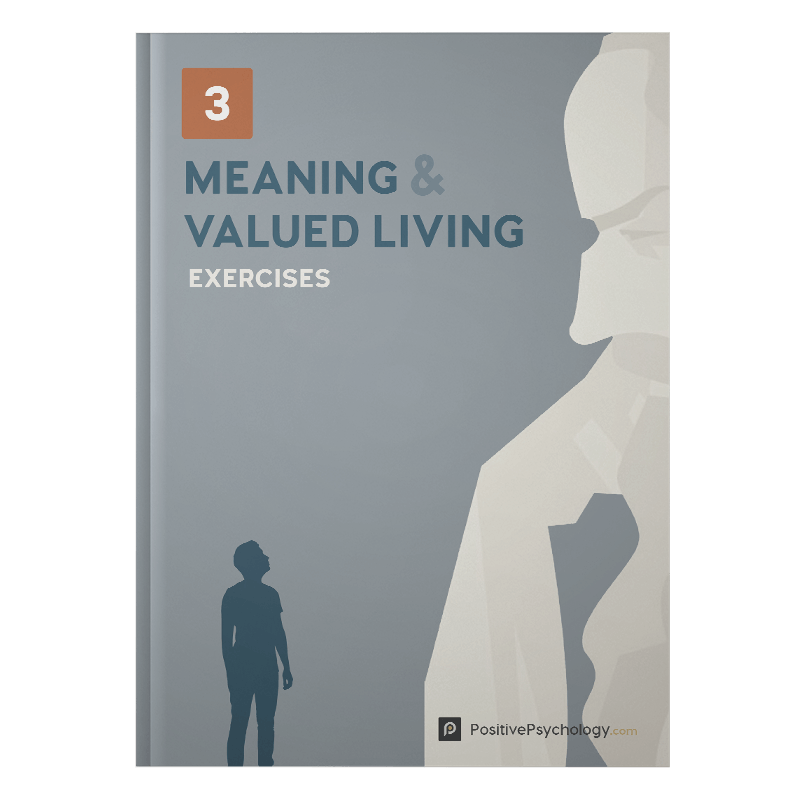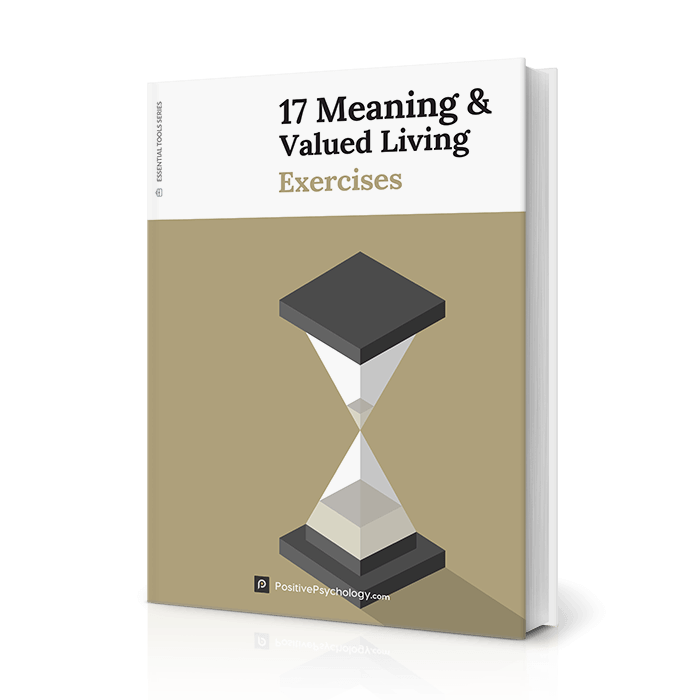How to Accept the Impermanence of Life: A Buddhist Take

Accepting that all circumstances are subject to change, both from bad to better and from good to worse, helps us manage life’s ups and downs.
For Buddhists, the reality of continuous change is one of the characteristics of our human existence and is often translated from the Pali term anicca as “impermanence” (Nyanaponika Thera, 2006).
This article will discuss the meaning of impermanence and its importance to Buddhism. We explain how you can design your life to accommodate impermanence to enhance your overall wellbeing in the face of the inevitable cycles of loss and change.
Before you continue, we thought you might like to download our three Meaning and Valued Living Exercises for free. These creative, science-based exercises will help you learn more about your values, motivations, and goals and give you the tools to inspire a sense of meaning in the lives of your clients, students, or employees.
This Article Contains:
What Is the Meaning of Impermanence?
Impermanence refers to the uncertain and temporary nature of much of what we regard as reality. However, despite the reality of continuous change, we often mistakenly invest in multiple aspects of life as if they are fixed and certain, such as our relationships, jobs, income, and housing.
Expecting temporary circumstances to remain permanent intensifies the pain and suffering of loss, grief, rejection, and disappointment when change does arise.
Nevertheless, when we investigate the nature of reality, we discover that things are constantly changing, even things that appear solid and permanent to the naked eye. For example, your house may look solid, but without continuous maintenance and care, it will deteriorate, decay, and crumble, eventually returning to the earth.
Recognizing the all-pervading nature of impermanence can trigger anxiety about life’s uncertain and unpredictable nature. Yet, according to Buddhism, accepting impermanence can also be liberating because it opens us up to a world of endless possibilities (SN 36.9).
It is beneficial to remember the reality of impermanence during pain, grief, and other trials, understanding that these, too, will change (SN 22.102).
Impermanence in Buddhism

The Buddha taught that the phenomenal world is transitory and changes according to causes and conditions, such as nature’s cycles of creation and destruction, the human life cycle, relationships, and even history with the rise and fall of different cultures.
For Buddhists, a lack of awareness of the impermanence of the phenomenal world is caused by ignorance (Nhat Hanh, 2015). In turn, ignorance causes the attachment, craving, and clinging that lead to suffering (Chodron, 2000). Nirvana is a state of mind free from suffering and refers to the extinguishing of the “fire” of personal desire that fuels attachment (Thanissaro Bhikkhu, 2011). Achieving nirvana is required for enlightenment.
An enlightened mind perceives both the impermanence of the phenomenal world, termed conventional or relative truth, alongside the absolute or ultimate truth, which underpins our conventional experience of reality. Ultimate truth refers to the dharmic law explained by the Buddha’s teachings and is permanent rather than time bound. The perception of ultimate truth is the result of extensive scholarly training and the cultivation of insight in meditation.
For Mahayana Buddhists, this teaching is referred to as the Two Truths. This was a late addition to Buddhism and is not based on the Buddha’s original discourses in the Pali canon (Thanissaro Bhikkhu, 2020).
As such, some debate remains between the early Buddhists or Theravadins (practiced in Buddhist cultures like Sri Lanka, Thailand, and Myanmar) and the later Mahayana Buddhists (practiced in Buddhist cultures like China, Tibet, Korea, and Japan) about how to explain the meaning of impermanence.
However, the distinction between the Two Truths honors the reality of both relative and ultimate truth, rather than prizing one type of truth over the other. This is a key difference between the Hindu and Buddhist take on impermanence.
Hindu yogis hold only the absolute or eternal as “real” and regard all that is impermanent as “unreal.” For Buddhists, both the relative and ultimate truth are real.
In the video below, Buddhist nun and teacher Pema Chodron describes her initial encounter with the Buddhist understanding of impermanence as a student of the Tibetan Mahayana and how she learned to relax with it, especially in relation to her mortality.
Buddhist meaning of life
For Buddhists, all sentient beings participate in a cyclic process of living, dying, and rebirth called the wheel of samsara (Nhat Hanh, 2015). The purpose of life is to achieve freedom from this cyclic process of suffering by attaining nirvana or enlightenment (Nhat Hanh, 2021).
Siddhartha Gautama, who became the Buddha in ancient India in approximately 528 BC, first taught the method for achieving liberation from suffering based on the Four Noble Truths. The complete realization of the Four Noble Truths leads to enlightenment or Buddhahood (Dalai Lama, 1998).
For a fascinating account of the life of the Buddha and his core teachings, you might want to watch this documentary film narrated by many authorities on Buddhism, including the Dalai Lama. It’s a full-length feature film rather than a pithy summary, so you’ll have to make the time, but it’s worth it!
Four Noble Truths
Following his enlightenment, the first teaching Buddha gave his disciples when turning the wheel of dharma* was the Four Noble Truths (Dalai Lama, 1998).
These truths belong to the realm of ultimate truth and are veiled by the lack of insight caused by ignorance. However, given the relative reality of impermanence, we human beings can transform our ignorance into awareness through the cultivation of wisdom in meditation (Nhat Hanh, 2015).
The Four Noble Truths can be summarized as follows.
- The truth that life is suffering
- The truth of the causes of suffering
- The truth of the cessation of suffering
- The truth of the path to the cessation of suffering, called the Noble Eightfold Path
In this video, psychotherapist Dr. Miles Neal describes each element of the Buddha’s first teaching of the Four Noble Truths and explains how cultivating insight through meditation leads to peace and psychological freedom.
* The wheel of dharma or dharmachakra is often depicted in Buddhist temples by an eight spoked wheel. This contrasts with the wheel of samsara and refers to the Noble Eightfold Path out of suffering and out of samsara.
Buddhism happiness

This contrasts starkly with the temporary enjoyment of the pleasures of the senses, often termed “happiness” in the secular West (Chodron, 2000).
In addition to cultivating the realization of the Four Noble Truths, Buddhists also cultivate happiness through meditation on the Four Brahma Viharas (also called the four divine abodes or the four immeasurables). These are metta (loving-kindness), karuna (compassion), mudita (appreciative joy), and uppekha (equanimity; Feldman, 2017).
Practicing the Four Brahma Viharas cultivates healthy emotions, while reflecting on the Four Noble Truths cultivates wisdom and insight. Combining these practices is especially powerful and will help develop inner peace and eventually freedom from suffering (Nyanatiloka Mahathera, 1969).
For a clear explanation of the Four Brahma Viharas, check out Dr. Doug Smith’s video introduction to the history and meaning of these practices and their importance for early Buddhism.
Anicca, dukkha, and anatta
The Buddha also explained that the human experience of the phenomenal world is characterized by the Three Characteristics of Existence, as follows.
- Anicca refers to the impermanent and ever-changing nature of phenomenal reality. The reality of impermanence applies to both inanimate and animate beings — to all the elements, vegetative life, and sentient beings, like animals and humans.
As human beings, anicca means we are subject to the ongoing cycle of life, death, and rebirth: aging, sickness, and death. However, we also enjoy the continuous possibility of transformation and liberation from suffering (Nyanaponika Thera, 2006). - Dukkha refers to the persistent dissatisfaction caused by ignorance of anicca, which leads to craving and attachment. This affects sentient beings only, not natural elements or plant life.
The ongoing dissatisfaction of clinging, craving, and attachment due to wanting things to be different is caused by ignorance and can be eliminated through insight into impermanence (Nhat Hanh, 2015). - Anatta refers to our mistaken identification with a sense of a permanent self or ego, which is illusory. Anatta is often translated as “not-self,” pointing to the Buddha’s teaching on dependent origination and the interconnectedness of all phenomena.
Anatta means that nothing has a boundaried material identity, not even our own sense of self. Instead, everything is related and depends upon everything else (Nhat Hanh, 2015).
According to Buddhists, when we examine the nature of “I’ in meditation and try to determine its essence, we find nothing that is permanent or identifiably solid. Instead, what we take to be a solid sense of “me” is a succession of ever-changing moments with no inherent existence of their own.
The sense of a fixed “I” or “me” is an illusion caused by ignorance (AN 4.49). When we cultivate awareness in meditation, we gain insight into our sense of self as a dynamic, interdependent process rather than materially independent, fixed, and solid (Smith, 2010).
Awareness of the Three Characteristics of Existence — anicca, dukkha, and anatta — reveals how reality offers us continuous possibilities for transformation and change.
The law of impermanence

Therefore, the law of impermanence is both good and bad news. The bad news is that nothing we enjoy stays the same. It changes and ends. The good news is that the suffering caused by our clinging to conditioned things can also be transformed through study and meditation.
The law of impermanence also underpins what Thich Nhat Hahn (2015) called “interbeing,” which refers to the Buddha’s teaching on the 12 links of dependent origination. This explains the interconnectedness of all things, including our human experience of our bodies, minds, thoughts, emotions, and perceptions. Impermanence drives the dynamic process of interbeing.
In this short video below, Thich Nhat Hanh describes how impermanence is linked to the Buddhist teaching of emptiness and how impermanence relates to interbeing and, paradoxically, the fullness of life.
How to Accept the Impermanence of Life
Key to accepting the impermanence of life is an appreciation of the present moment in all its fullness. As Pema Chodron describes in the video above, each moment passes, never to be repeated. Life is a succession of moments, a chain of births and deaths, which is magnified in the cycle of life and death that Buddhists call samsara.
When we learn how to accept the impermanence of life, each moment becomes more precious as we realize its fleeting nature. Each life form becomes more precious as we realize the vulnerability of all life to aging, sickness, injury, and death.
We may even realize every new day could be our last and so live it to the fullest extent possible, not by indulging in the mindless hedonism that ultimately leads to suffering, but mindfully with full awareness of each passing moment (Chodron, 2000).
A brief mindful breathing practice can be the first step to appreciating and accepting impermanence. Psychotherapist Elaine Smookler (n.d., para 8) from the Centre for Mindfulness Studies in Toronto suggests the following method for accepting the crucial role impermanence has in living fully:
“Try this practice and notice if it helps you feel more present:
- Pay particular attention to the breath coming in.
- Notice the physical sensations of breathing.
- Continue to pay attention to the ‘in-breath.’ Notice yourself being here, right now.
- Shift your attention to the sensation of the breath leaving the body.
In this basic act of breathing in and out, we have the experience of impermanence. Our breath comes in, our breath goes out. If we try to hold on to either, we die.”
This simple practice reminds us that the acceptance of impermanence need not condemn us to a perpetual state of anxiety about the uncertainty of our existence, but instead can help us appreciate the reality of continuous possibility evident in each round of the breath.
In my blog post on the Mindfulness of Death, I also explain how an appreciation of the impermanence of life can improve our quality of life and especially our relationships. When discussing the mindfulness of death, the Buddha said:
“People, other than the wise, do not realize, ‘We in this world must all die,’ (and, not realizing it, continue their quarrels). The wise realize it and thereby their quarrels cease” (Dhammapada, n.d./300, Verse 6).
When we remain mindfully alert to the possibility of death, fighting and quarreling over things seems trivial. Consequently, our relationships improve.
You might want to try one of the mindfulness of death meditations recommended in my article to cultivate acceptance of the impermanence of life. Far from being morbid, these practices can paradoxically enhance our sense of gratitude for life and zest for living. However, they should be approached with caution if you are grieving a recent loss.
How to Design Our Lives for Impermanence
Psychological flexibility is key to designing our lives for impermanence and is a cornerstone of most mindfulness-based interventions, especially Acceptance and Commitment Therapy (ACT; Hayes & Smith, 2005).
Much of the pain we experience in life is inevitable. However, suffering can be reduced when we cultivate acceptance of impermanence, learn to stop resisting, and appreciate that the moment will pass rather than use avoidance strategies that cling to how we’d like things to be (Harris, 2008).
While ACT refers to a therapeutic intervention, it can also be used as a form of self-help to navigate your way through the inevitable ups and downs of life. Take a look at our ACT article with 21 useful worksheets, which can help develop the psychological flexibility needed to embrace impermanence.
Accepting imperfection is also key to designing our lives for impermanence. My article on The Wabi Sabi Lifestyle explains how appreciating the imperfections caused by impermanence can enhance our connection to the present moment using methods with roots in the Zen tea ceremony practiced in Japan (Kempton, 2018).
Finally, any type of mindfulness practice will help you develop the flexibility and resilience to design your life for impermanence.
5 Quotes About Impermanence
“The perceiving of impermanence, bhikkhus, developed and frequently practiced, removes all sensual passion, removes all passion for material existence, removes all passion for becoming, removes all ignorance, removes and abolishes all conceit of ‘I am.’”
Buddha, SN 22.102
“The five aggregates, monks, are anicca, impermanent; whatever is impermanent, that is dukkha, unsatisfactory; whatever is dukkha, that is without attaa, self. What is without self, that is not mine, that I am not, that is not my self. Thus should it be seen by perfect wisdom as it really is. Who sees by perfect wisdom, as it really is, his mind, not grasping, is detached from taints; he is liberated.”
Buddha, SN 22.45 (as cited in Nyanaponika Thera, 2006)
“It is not impermanence that makes us suffer. What makes us suffer is wanting things to be permanent when they are not.”
Thich Nhat Hanh, 2015, p. 132
“Impermanence is a principle of harmony. When we don’t struggle against it, we are in harmony with reality.”
Pema Chodron, 2000, p. 78
“The notion is called wabi-sabi life, like the cherry blossom, it is beautiful because of its impermanence, not in spite of it, more exquisite for the inevitability of loss.”
Peggy Orenstein, 2008, p. 126
A Take-Home Message
While the Buddhist teaching on impermanence can be unsettling, it is also the cornerstone of the possibility of psychological transformation.
Impermanence is easily witnessed in the cycles of life and death that are all around us in the plant and animal kingdom and in the rise and fall of civilizations throughout human history. It is also evident in changing geological formations and of course, climate change.
Deep awareness of the reality of impermanence can help us take the ups and downs of life less personally, especially the tragedies, losses, disappointments, and rejections we all endure at different times.
Yet the reality of impermanence is also crucial for personal transformation, healing, and creative change. An awareness of impermanence can help us appreciate the possibilities offered by the many paths toward personal development that lead to a more fulfilled way of life.
We hope you enjoyed reading this article. Don’t forget to download our three Meaning and Valued Living Exercises for free.
- AN 4.49: Vipallasa Sutta: Distortions of the mind (Andrew Olendzki, Trans.). (2013). Access to Insight. https://www.accesstoinsight.org/tipitaka/an/an04/an04.049.olen.html.
- Chodron, P. (2000). When things fall apart: Heart advice for difficult times. Shambhala.
- Dalai Lama. (1998). The Four Noble Truths. Thorsons.
- Dhammapada. (n.d.). Tipitaka Network. (Original work published 300). https://www.tipitaka.net/tipitaka/dhp/verseload.php?verse=006.
- Feldman, C. (2017). Boundless heart: The Buddha’s path of kindness, compassion, joy, and equanimity. Shambhala.
- Harris, R. (2008). The happiness trap. Robinson.
- Hayes, S. C., & Smith, S. (2005). Get out of your mind and your life – The new acceptance and commitment therapy. New Harbinger.
- Kempton, B. (2018). Wabi sabi: Japanese wisdom for a perfectly imperfect life. Piatkus.
- Nhat Hanh, T. (2015). The heart of the Buddha’s teaching: Transforming suffering into peace, joy, and liberation. Harmony.
- Nhat Hanh, T. (2021). Enjoying the ultimate. The nirvana chapter of the Dharmapada. Parallax Press.
- Nyanatiloka Mahathera. (1969). The Buddha’s path to deliverance in its threefold division and seven stages of purity (3rd ed.). Lake House Printers and Publishers.
- Nyanaponika Thera. (2006). The three basic facts of existence: I. Impermanence (Anicca). Access to Insight. http://www.accesstoinsight.org/lib/authors/various/wheel186.html.
- Orenstein, P. (2008). Waiting for Daisy: A tale of two continents, three religions, five infertility doctors, an Oscar, an atomic bomb, a romantic night and one woman’s quest to become a mother. Bloomsbury.
- Smith, R. (2010). Stepping out of self-deception: The Buddha’s liberating teaching of no-self. Shambhala.
- Smookler, E. (n.d.) Accepting impermanence. Centre for Mindfulness Studies. https://www.mindfulnessstudies.com/accepting-impermanence/.
- SN 22.102: Perception of impermanence (Bhante Sujato, Trans.) (2018.) Open Buddhist University. https://buddhistuniversity.net/content/canon/sn22.102.
- SN 36.9: Anicca Sutta: Impermanent (Nyanaponika Thera, Trans.). (2010). Access to Insight. https://www.accesstoinsight.org/tipitaka/sn/sn36/sn36.009.nypo.html.
- Thanissaro Bhikkhu. (2011). Nibbana. Access to Insight. http://www.accesstoinsight.org/lib/authors/thanissaro/nibbana.html.
- Thanissaro Bhikkhu. (2020).The mirror of insight. Metta Forest Monastery. https://www.dhammatalks.org/books/Mirror_ofInsight/Section0005.html
Let us know your thoughts
Read other articles by their category
- Body & Brain (49)
- Coaching & Application (57)
- Compassion (26)
- Counseling (51)
- Emotional Intelligence (24)
- Gratitude (18)
- Grief & Bereavement (21)
- Happiness & SWB (40)
- Meaning & Values (26)
- Meditation (20)
- Mindfulness (45)
- Motivation & Goals (45)
- Optimism & Mindset (34)
- Positive CBT (28)
- Positive Communication (20)
- Positive Education (47)
- Positive Emotions (32)
- Positive Leadership (18)
- Positive Parenting (4)
- Positive Psychology (33)
- Positive Workplace (37)
- Productivity (17)
- Relationships (46)
- Resilience & Coping (36)
- Self Awareness (21)
- Self Esteem (38)
- Strengths & Virtues (32)
- Stress & Burnout Prevention (34)
- Theory & Books (46)
- Therapy Exercises (37)
- Types of Therapy (64)






What our readers think
Amazing peice of work thank you.
Nicely explained, well searched, innovative
Well researched, referenced and put together, a good overview of some of the main Buddhist teachings and with helpful links which go into more depth and detail. Well done.
This is very much in the philosophical text, Honestly, undertood oeverall, Every particle of our body is continually changing, and the end everything born must die.
Always moving forwards in the body and the mind Letting go of attachments offers freedom peace and many blessings that give us further wisdom
This is exactly what I needed to read this morning, especially the last part and excerpt. You have knowledge and wisdom beyond your years. Please continue to share it. Thank you!